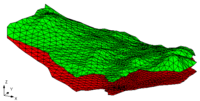GMS:TIN Settings: Difference between revisions
From XMS Wiki
Jump to navigationJump to search
No edit summary |
No edit summary |
||
| Line 1: | Line 1: | ||
{{TIN links}} | {{TIN links}} | ||
:'''Retriangulate After Deleting''' | :'''Retriangulate After Deleting''' – If this option is on, the region surrounding the vertex is retriangulated as each vertex is deleted. Otherwise, the triangles adjacent to the vertex are simply deleted. | ||
:'''Adjust Boundary to Include Exterior Vertices''' - If this option is on, the boundary of the TIN is changed so that the new vertex becomes part of the TIN if a new point is added outside the active TIN. If the new vertex is in the interior of the active TIN, the vertex is automatically incorporated into the TIN. | :'''Adjust Boundary to Include Exterior Vertices''' - If this option is on, the boundary of the TIN is changed so that the new vertex becomes part of the TIN if a new point is added outside the active TIN. If the new vertex is in the interior of the active TIN, the vertex is automatically incorporated into the TIN. | ||
:'''Default Z-Value''' | :'''Default Z-Value''' – The default z value is assigned to all new vertices created with the Create Vertex tool. | ||
:'''Confirm Z-Values''' | :'''Confirm Z-Values''' – If this option is on, GMS prompts for a z value each time a new vertex is created. | ||
:'''Interpolate For Default Z On Interior''' | :'''Interpolate For Default Z On Interior''' – If this option is on and a new vertex is created in the interior of a TIN, a default z-value is linearly interpolated from the plane equation defined by the triangle containing the point. | ||
:'''Extrapolate For Default Z On Exterior''' | :'''Extrapolate For Default Z On Exterior''' – If this option is on and a new vertex is entered outside the TIN boundary, a default z-value is extrapolated from the TIN to the new vertex. | ||
{{Navbox GMS}} | {{Navbox GMS}} | ||
[[Category:TINs]] | [[Category:TINs]] | ||
